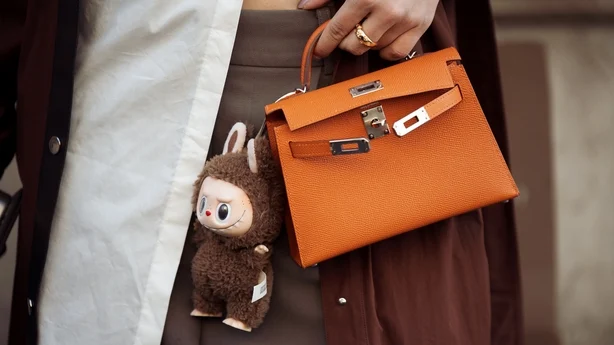Labubus are charming little monsters. They have a shy, snaggletoothed smile. Their coat is curly. They also have long ears. These features make them “ugly cute.” They have become very popular online. You have likely seen them. They dangle from keychains and bags. People also unbox them on social media.
Origin and Rise to Fame
These collectible furry companions draw inspiration. They come from Nordic folklore and mythology. Hong Kong-born artist Kasing Lung created Labubu. Labubu is one character in “The Monster series.” This series features blind-box toys. Chinese toy company PopMart sells them. Labubus have existed for a decade.
However, they gained huge TikTok popularity recently. Celebrity approval has also boosted their fame. This happened in the last year or two.
Celebrity Endorsements and Online Buzz
These toothy, fleecy toys are trending. Their hashtag has 1.3 million TikTok posts. Many celebrities are fans. Pop divas Rihanna, Lisa, and Dua Lipa love them. “Love Island” alumni Olivia Attwood is also a fan.
The Blind Box Phenomenon
PopMart is not the only company in this market. Dreams Inc., a Japanese company, makes blind box toys. Sonny Angels and Smiskis are examples. These have found new audiences. They appeal beyond kawaii culture’s capital.
The mystery is part of the fun. Blind boxes never reveal the exact character inside. They show possible options. This adds excitement. It creates an urge to open the packaging.
A Nostalgic Impulse
This impulse is similar to lucky bags. Newsagents once sold lucky bags. They were at child eye-level. They triggered “pester power.” Securing a lucky bag was a core childhood memory. Many who grew up in Ireland share this. Access to a local corner shop was common.
This exciting element of surprise now translates to adults. It appears through these blind box characters. They are big business. The global market value is estimated to reach $391.62 billion by 2030.
The Thrill of the “Secret” Character
Any blind box series typically has six to ten characters. There are many series, like Molly or SkullPanda. There is always a chance to find the “secret” character. The “secret” is a rare, extra design.
In the new Big into Energy Series, a secret Labubu exists. It is a grey monster with rainbow teeth. The chance of drawing it is one in 72. This taps into “completionism.” This is the desire to complete every aspect of something. Often used in video games, it also applies to collecting. It fuels the urge to get every piece of a set. Rare and valuable items always appeal to collectors.
Demand and Safety Concerns
Desire for these figurines has peaked. Reports of shoppers fighting over toys emerged. This led to PopMart pulling stock. They removed items from all 16 UK stores. This was to “prevent any potential safety issues.”
Why People Collect: Joy and Community
Fans of these collectibles cite childhood joy. This is a key appeal factor. “People have always loved collectables,” says Davie Jordan Andrews. He is a Dublin-based collector. Examples include McDonald’s toys and football cards. “They were simpler times!” he adds.
“Saving up your pocket money to buy stuff to trade with your friends, this is the same concept but in adult form,” Davie explains. He collects Labubu’s Monster series, Smiski, Sonny Angels, and Crybaby characters. “These new collectables are so hard to get your hands on,” he states. “It’s definitely a ‘want what you can’t have’ situation.”
Davie’s love for collecting started early. He collected trinkets, Pokémon, and Yu-Gi-Oh cards. “I think I got my love for them from my Nanny,” he says. “As she loved collecting porcelain dolls and vintage ceramics.”
Social Aspects and Online Engagement
Buying a mystery item is not new. But blind boxes have a social incentive too. Industry giants work with artists. This creates unique collections. This gives them a creative appeal. The small characters make ideal accessories or decor.
Online communities of blind box collectors have emerged. Social media platforms host them. Influencers unbox entire sets live. They also create dedicated unboxing videos.
Davie discovered these collectibles on social media. He has built his own community of Labubu lovers. He creates unboxing videos. He shares his collection of cute creatures. They help each other find blind boxes.
“When I posted my video, I got over 100 messages,” Davie shares. People asked where he got his. “I have been trying to help people find one,” he says. “A lovely girl that follows me texted me recently on TikTok.” She let him know the Labubu he wanted was back in stock. “I got it,” he confirms. “When you see someone opening a Labubu for the first time or getting what they really wanted, you can’t help but feel really happy for them.”
Beyond Childhood: Adult Collectors
Collecting can stem from childhood. However, these toys are not just for kids. Research shows the main consumer group. They are between ages 18 and 35.
“The only misconception about the community is that we are wasting our money on toys that are for ‘children’,” Davie states. “I completely disagree; these are collectables for everyone.” He plans to keep his forever. “One day will be handing them down to my children!” he says. “They are like Marmite, you either love them or hate them, and I love them!”
Environmental Considerations
Collecting is inherent in human nature. But nature itself might suffer. PopMart encourages customers to recycle packaging. They use CPP film-based bags. This material can be biodegradable. Boxes and cartons are made of recyclable cardboard.
However, overconsumption is a concern. Especially of plastic and synthetic goods. This is not good for the environment. Demand for blind box figures continues to grow. Environmental pushback has already begun. Manufacturers may soon face pressure. They may need to use renewable and recycled materials.
In the meantime, notice how many you spot. Look during your next walk through town. The blind box boom continues to expand.








